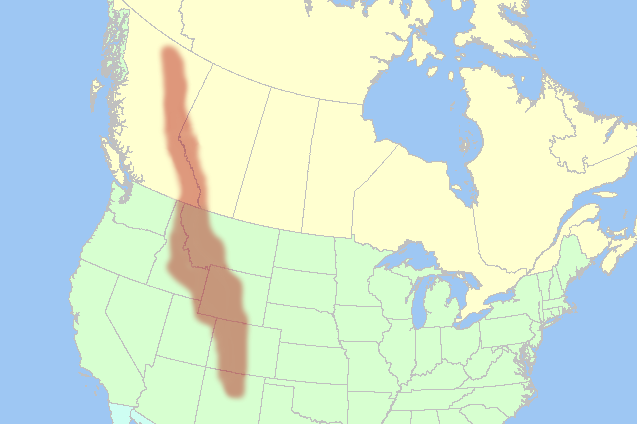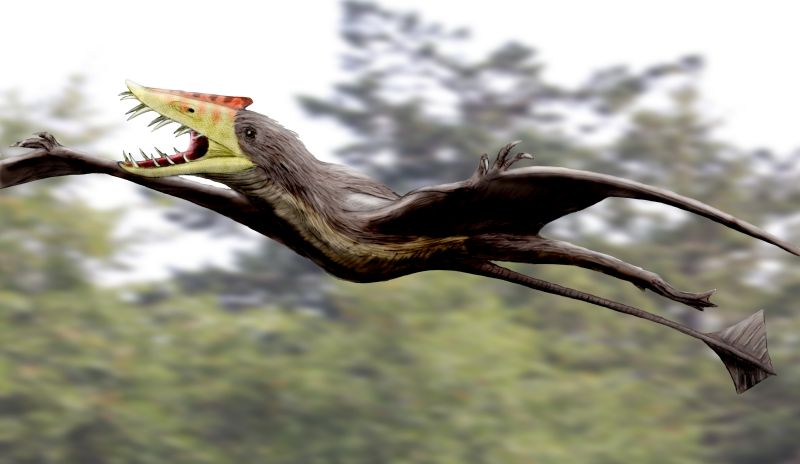|
Geology Of The Rocky Mountains
The geology of the Rocky Mountains is that of a discontinuous series of mountain ranges with distinct geological origins. Collectively these make up the Rocky Mountains, a mountain system that stretches from Northern British Columbia through central New Mexico and which is part of the great mountain system known as the North American Cordillera. The rocky cores of the mountain ranges are, in most places, formed of pieces of continental crust that are over one billion years old. In the south, an older mountain range was formed 300 million years ago, then eroded away. The rocks of that older range were reformed into the Rocky Mountains. The Rocky Mountains took shape during an intense period of plate tectonic activity that resulted in much of the rugged landscape of the western North America. The Laramide orogeny, about 80–55 million years ago, was the last of the three episodes and was responsible for raising the Rocky Mountains. Subsequent erosion by glaciers has created the ... [...More Info...] [...Related Items...] OR: [Wikipedia] [Google] [Baidu] |
Pennsylvanian (geology)
The Pennsylvanian ( , also known as Upper Carboniferous or Late Carboniferous) is, in the International Commission on Stratigraphy, ICS geologic timescale, the younger of two period (geology), subperiods (or upper of two system (stratigraphy), subsystems) of the Carboniferous Period. It lasted from roughly . As with most other geochronology, geochronologic units, the stratum, rock beds that define the Pennsylvanian are well identified, but the exact date of the start and end are uncertain by a few hundred thousand years. The Pennsylvanian is named after the U.S. state of Pennsylvania, where the coal-productive beds of this age are widespread. The division between Pennsylvanian and Mississippian (geology), Mississippian comes from North American stratigraphy. In North America, where the early Carboniferous beds are primarily marine limestones, the Pennsylvanian was in the past treated as a full-fledged geologic period between the Mississippian and the Permian. In parts of Europe, ... [...More Info...] [...Related Items...] OR: [Wikipedia] [Google] [Baidu] |
Cretaceous
The Cretaceous ( ) is a geological period that lasted from about 145 to 66 million years ago (Mya). It is the third and final period of the Mesozoic Era, as well as the longest. At around 79 million years, it is the longest geological period of the entire Phanerozoic. The name is derived from the Latin ''creta'', "chalk", which is abundant in the latter half of the period. It is usually abbreviated K, for its German translation ''Kreide''. The Cretaceous was a period with a relatively warm climate, resulting in high eustatic sea levels that created numerous shallow inland seas. These oceans and seas were populated with now- extinct marine reptiles, ammonites, and rudists, while dinosaurs continued to dominate on land. The world was ice free, and forests extended to the poles. During this time, new groups of mammals and birds appeared. During the Early Cretaceous, flowering plants appeared and began to rapidly diversify, becoming the dominant group of plants across the Earth b ... [...More Info...] [...Related Items...] OR: [Wikipedia] [Google] [Baidu] |
Formation (geology)
A geological formation, or simply formation, is a body of rock having a consistent set of physical characteristics ( lithology) that distinguishes it from adjacent bodies of rock, and which occupies a particular position in the layers of rock exposed in a geographical region (the stratigraphic column). It is the fundamental unit of lithostratigraphy, the study of strata or rock layers. A formation must be large enough that it can be mapped at the surface or traced in the subsurface. Formations are otherwise not defined by the thickness of their rock strata, which can vary widely. They are usually, but not universally, tabular in form. They may consist of a single lithology (rock type), or of alternating beds of two or more lithologies, or even a heterogeneous mixture of lithologies, so long as this distinguishes them from adjacent bodies of rock. The concept of a geologic formation goes back to the beginnings of modern scientific geology. The term was used by Abraham Gottlob Wer ... [...More Info...] [...Related Items...] OR: [Wikipedia] [Google] [Baidu] |
Mesozoic
The Mesozoic Era ( ), also called the Age of Reptiles, the Age of Conifers, and colloquially as the Age of the Dinosaurs is the second-to-last era of Earth's geological history, lasting from about , comprising the Triassic, Jurassic and Cretaceous Period (geology), Periods. It is characterized by the dominance of archosaurian reptiles, like the dinosaurs; an abundance of conifers and ferns; a hot Greenhouse and icehouse earth, greenhouse climate; and the tectonic break-up of Pangaea. The Mesozoic is the middle of the three eras since Cambrian explosion, complex life evolved: the Paleozoic, the Mesozoic, and the Cenozoic. The era began in the wake of the Permian–Triassic extinction event, the largest well-documented mass extinction in Earth's history, and ended with the Cretaceous–Paleogene extinction event, another mass extinction whose victims included the non-avian dinosaurs, Pterosaur, pterosaurs, Mosasaur, mosasaurs, and Plesiosaur, plesiosaurs. The Mesozoic was a time of ... [...More Info...] [...Related Items...] OR: [Wikipedia] [Google] [Baidu] |
Sedimentary Depositional Environment
In geology, depositional environment or sedimentary environment describes the combination of physical, chemical, and biological processes associated with the deposition of a particular type of sediment and, therefore, the rock types that will be formed after lithification, if the sediment is preserved in the rock record. In most cases, the environments associated with particular rock types or associations of rock types can be matched to existing analogues. However, the further back in geological time sediments were deposited, the more likely that direct modern analogues are not available (e.g. banded iron formations). Types of depositional environments Continental * – type of Fluvial deposit. Caused by moving water in a fan shape (Alluvial Fan) and containing mostly impermeable and nonporous sediments well sorted. * . Often in deserts and coastal regions and well sorted, large scale cross-beds * – processes due to moving water, mainly streams. Common sediments are grav ... [...More Info...] [...Related Items...] OR: [Wikipedia] [Google] [Baidu] |
Continent
A continent is any of several large landmasses. Generally identified by convention rather than any strict criteria, up to seven geographical regions are commonly regarded as continents. Ordered from largest in area to smallest, these seven regions are: Asia, Africa, North America, South America, Antarctica, Europe, and Australia. "Most people recognize seven continents—Asia, Africa, North America, South America, Antarctica, Europe, and Australia, from largest to smallest—although sometimes Asia and Europe are considered a single continent, Eurasia." Variations with fewer continents may merge some of these, for example America, Eurasia, or Afro-Eurasia are sometimes treated as single continents, which can bring the total number as low as four. Zealandia, a largely submerged mass of continental crust, has also been described as a continent. Oceanic islands are frequently grouped with a nearby continent to divide all the world's land into geographical regions. Under t ... [...More Info...] [...Related Items...] OR: [Wikipedia] [Google] [Baidu] |
Western Interior Seaway - 95Ma
Western may refer to: Places *Western, Nebraska, a village in the US *Western, New York, a town in the US *Western Creek, Tasmania, a locality in Australia *Western Junction, Tasmania, a locality in Australia *Western world, countries that identify with shared "Western" culture Arts and entertainment Films * ''Western'' (1997 film), a French road movie directed by Manuel Poirier * ''Western'' (2017 film), a German-Austrian film Genres *Western (genre), a category of fiction and visual art centered on the American Old West **Western fiction, the Western genre as featured in literature **Western music (North America), a type of American folk music Music * ''Westerns'' (EP), an EP by Pete Yorn *WSTRN, a British hip hop group from west London Business *The Western, a closed hotel/casino in Las Vegas, United States *Western Cartridge Company, a manufacturer of ammunition *Western Publishing, a defunct publishing company Educational institutions *Western Washington University i ... [...More Info...] [...Related Items...] OR: [Wikipedia] [Google] [Baidu] |
Sedimentary Rock
Sedimentary rocks are types of rock that are formed by the accumulation or deposition of mineral or organic particles at Earth's surface, followed by cementation. Sedimentation is the collective name for processes that cause these particles to settle in place. The particles that form a sedimentary rock are called sediment, and may be composed of geological detritus (minerals) or biological detritus (organic matter). The geological detritus originated from weathering and erosion of existing rocks, or from the solidification of molten lava blobs erupted by volcanoes. The geological detritus is transported to the place of deposition by water, wind, ice or mass movement, which are called agents of denudation. Biological detritus was formed by bodies and parts (mainly shells) of dead aquatic organisms, as well as their fecal mass, suspended in water and slowly piling up on the floor of water bodies (marine snow). Sedimentation may also occur as dissolved minerals precipitate from ... [...More Info...] [...Related Items...] OR: [Wikipedia] [Google] [Baidu] |
Mesozoic Era
The Mesozoic Era ( ), also called the Age of Reptiles, the Age of Conifers, and colloquially as the Age of the Dinosaurs is the second-to-last Era (geology), era of Earth's Geologic time scale, geological history, lasting from about , comprising the Triassic, Jurassic and Cretaceous Period (geology), Periods. It is characterized by the dominance of archosaurian reptiles, like the dinosaurs; an abundance of conifers and ferns; a hot Greenhouse and icehouse earth, greenhouse climate; and the tectonic break-up of Pangaea. The Mesozoic is the middle of the three eras since Cambrian explosion, complex life evolved: the Paleozoic, the Mesozoic, and the Cenozoic. The era began in the wake of the Permian–Triassic extinction event, the largest well-documented mass extinction in Earth's history, and ended with the Cretaceous–Paleogene extinction event, another mass extinction whose victims included the non-avian dinosaurs, Pterosaur, pterosaurs, Mosasaur, mosasaurs, and Plesiosaur, ples ... [...More Info...] [...Related Items...] OR: [Wikipedia] [Google] [Baidu] |
San Juan Mountains
The San Juan Mountains is a high and rugged mountain range in the Rocky Mountains in southwestern Colorado and northwestern New Mexico. The area is highly mineralized (the Colorado Mineral Belt) and figured in the gold and silver mining industry of early Colorado. Major towns, all old mining camps, include Creede, Lake City, Silverton, Ouray, and Telluride. Large scale mining has ended in the region, although independent prospectors still work claims throughout the range. The last large scale mines were the Sunnyside Mine near Silverton, which operated until late in the 20th century and the Idarado Mine on Red Mountain Pass that closed down in the 1970s. Famous old San Juan mines include the Camp Bird and Smuggler Union mines, both located between Telluride and Ouray. The Summitville mine was the scene of a major environmental disaster in the 1990s when the liner of a cyanide-laced tailing pond began leaking heavily. Summitville is in the Summitville caldera, one of m ... [...More Info...] [...Related Items...] OR: [Wikipedia] [Google] [Baidu] |
Front Range
The Front Range is a mountain range of the Southern Rocky Mountains of North America located in the central portion of the U.S. State of Colorado, and southeastern portion of the U.S. State of Wyoming. It is the first mountain range encountered as one goes westbound along the 40th parallel north across the Great Plains of North America. The Front Range runs north-south between Casper, Wyoming, and Pueblo, Colorado, and rises nearly 10,000 feet above the Great Plains. Longs Peak, Mount Evans, and Pikes Peak are its most prominent peaks, visible from the Interstate 25 corridor. The area is a popular destination for mountain biking, hiking, climbing, and camping during the warmer months and for skiing and snowboarding during winter. Millions of years ago, the present-day Front Range was home to ancient mountain ranges, deserts, beaches, and even oceans. The name "Front Range" is also applied to the Front Range Urban Corridor, the populated region of Colorado and Wyoming just ... [...More Info...] [...Related Items...] OR: [Wikipedia] [Google] [Baidu] |







